
ACT Science Practice Test 34
Đề thi nằm trong bộ sưu tập: Tuyển Tập Bộ Đề Thi Đại Học Hoa Kỳ (ACT) - Có Đáp Án Chi Tiết
Số câu hỏi: 23 câuSố mã đề: 1 đềThời gian: 1 giờ
210,776 lượt xem 16,208 lượt làm bài
Xem trước nội dung:
More than 5 percent of Americans have asthma, a chronic disease that affects the airways and lungs, causing shortness of breath, wheezing, and sometimes death. In the United States, rates for asthma have steadily increased, nearly doubling during the past 20 years. There is no cure for asthma. Two researchers discuss factors that cause individuals to develop asthma.
Researcher 1
There has long been an association between the allergen Dermatophagoides pteronyssinus (dust mites) and asthma. Evidence for a causal relationship has been supported by bronchial challenge studies and avoidance experiments. Studies have shown that exposure in the child’s own house was the primary determinant of sensitization. Research from around the world has provided evidence about other indoor allergens, specifically cats, dogs, and the German cockroach. These studies showed that perennial exposure to allergens was an important cause of inflammation in the lungs and associated nonspecific bronchial hyperreactivity. Children are being exposed to more perennial allergens now than ever before. Houses are built more tightly and are better insulated and have more furnishings and fitted carpets. In addition, children are spending more time indoors. This increased exposure to allergens, including dust mites, has led to increased sensitization, and more cases of asthma.
Since assays for total serum IgE (immunoglobulin E) became available, it has been clear that patients with asthma have, on average, higher total IgE than patients with hay fever or no allergy. Recent work on patients hospitalized for asthma has suggested that the interaction between rhinovirus and allergy occurs predominantly among patients with total IgE > 200 IU/ml. Thus, the different properties of allergens could influence both the prevalence and severity of asthma.
Researcher 2
It is widely accepted that air pollution exacerbates asthma. For example, when traffic controls were put in place during the 1996 Summer Olympic Games in Atlanta, Georgia, morning peak traffic counts declined by 23 percent. This in turn lowered ozone (O3) concentrations by 13 percent, carbon monoxide (CO) by 19 percent, and nitrogen dioxide (NO2) by 7 percent. Associated with these declines in ambient air pollution were drops in Medicaid-related emergency room visits and hospitalizations for asthma (down 42 percent), asthma-related care for health maintenance organizations (down 44 percent), and citywide hospitalizations for asthma (down 19 percent). Despite such striking relationships between exposure to air pollution and asthma aggravation, air pollution has not been regarded as a cause of the disease. Increasingly, however, recent studies have been suggesting that air pollution may, indeed, be a cause of asthma.
The Children’s Health Study (CHS) followed 3,535 children with no lifetime history of asthma for five years. During that period 265 reported a new physician diagnosis of asthma. Analysis of CHS data has shown that children living in communities with high ozone levels developed asthma more often than those in less polluted areas. The hypothesis that ozone might cause asthma is reinforced by a study of 3,091 nonsmoking adults aged 27 to 87 years who were followed for 15 years. The results of this study showed that 3.2 percent of the men and 4.3 percent of the women reported new doctor-diagnosed asthma. The researchers concluded that there was a connection between ozone concentration and development of asthma.
If ozone levels decrease nationwide, Researcher 2 would expect to see what change in asthma rates?
An increase in the prevalence of asthma
A decrease in the prevalence of asthma
No change in the prevalence of asthma
First a decrease and then an increase in the prevalence of asthma
Which of the following statements would Researcher 1 agree with?
Asthma rates are lower in rural areas.
Men are more likely to have asthma than women.
People who have pets are more likely to have asthma.
Asthma rates are related to the quality of air.
Researcher 1 would most likely agree with which of the following statements about IgE?
People who have IgE levels of 400 IU/ml have a high chance of having severe asthma.
People who have IgE levels of 100 IU/ml have a high chance of having severe asthma.
Most people who have asthma have low levels of IgE; less than 200 IU/ml.
There has been no connection made between IgE levels and the prevalence of asthma.
If the prevalence of asthma in the United States continues to increase, Researcher 1 would likely cite which of the following as a solution to the problem?
People need to spend less time outside.
Houses need to be better insulated.
People need to be given supplements to increase their IgE levels.
Fans need to be added to houses to allow more circulation and to bring more outside air into the house.
Researchers 1 and 2 would both agree with which of the following statements?
Asthma rates are likely to decline over the next 20 years.
Air pollution and high IgE levels are the two leading causes of asthma.
Women are more likely to develop asthma than men.
Measures can be taken to lower a person’s risk of developing asthma.
If Researcher 2 is correct, which of the following graphs would best represent the relationship between CO concentrations and cases of asthma?

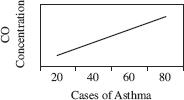

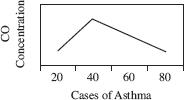
Researcher 2 would most likely agree with which of the following statements regarding the prevalence of asthma 20 years ago?
There was a higher prevalence of asthma 20 years ago because there was less pollution.
There was a lower prevalence of asthma 20 years ago because there were higher ozone levels and less pollution.
There was a lower prevalence of asthma 20 years ago because there was less pollution and lower ozone levels.
There was a lower prevalence of asthma 20 years ago because people spent more time outside.
The Great Lakes Science Center (GLSC) has conducted lakewide surveys of the fish community in Lake Michigan each fall since 1973 using standard 12 m bottom trawls along contour at depths of 9 to 110 m at each of seven to nine index transects. The resulting data on relative abundance, size structure, and condition of individual fishes are used to estimate various population parameters that are in turn used by state and tribal agencies in managing Lake Michigan fish stocks.

Figure 1
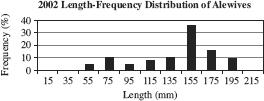
Figure 2

Figure 3
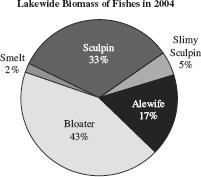
Figure 4
According to Figure 1, which species of fish was most prevalent in 1954?
Alewife
Smelt
Bloater
Smelt and bloater
Based on the information in Figure 4, which of the following statements is true?
There were more smelt than sculpin in 2004.
There were more bloater than sculpin in 2004.
There were more alewife than bloater in 2004.
There were more slimy sculpin than alewife in 2004.
According to Figure 2 and Figure 3, which of the following is NOT true about the size of alewives?
There were more 175-mm alewives in 2004 than in 2002.
There were fewer 75-mm alewives in 2004 than in 2002.
There were fewer 115-mm alewives in 2002 than in 2004.
There were more 155-mm alewives in 2004 than in 2002.
Considering the fact that the older an alewife fish, the longer it is, and using the data in Figures 2 and 3, which of the following can be deduced about alewife fish populations in 2002 and 2004?
In 2004 there were more young alewives than in 2002.
In 2004 there were more adult alewives than in 2002.
In 2004 the fish were, on average, younger than in 2002.
In 2004 the greatest percentages of fish were young.
Scientists at the GLSC have hypothesized that the bloater population may be cycling in abundance, with a period of about 30 years. Does the data in Figure 1 support this hypothesis?
No. The population of bloater fish has decreased since 1973.
No. In 2004 there were more bloater fish than any other species.
Yes. The density of bloater fish steadily increased before 1973 and then decreased from 1973 to 2003.
Yes. In 2004 there were more bloater fish than any other species.
Pertussis, commonly known as whooping cough, is a highly infectious disease of the respiratory tract caused by bacteria. The disease spreads by direct contact with secretions from the nose or throat of an infected person, or by breathing in the air when an infected person coughs. Pertussis most easily passes between people in the initial stage of illness, but it can be spread at any time during the course of the illness. Figure 1 depicts the course of pertussis from exposure to recovery.
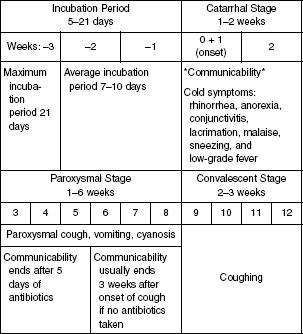
Figure 1
The number of reported cases of pertussis from 1974 through 2004 is depicted in Figure 2.
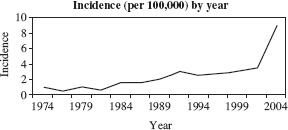
Figure 2
The number of reported cases of pertussis in 2004 by age group is shown in Figure 3.
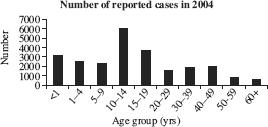
Figure 3
A new vaccine for pertussis was introduced in 1991, which claimed to be more effective than the previous vaccine. Does the data in Figure 2 support this claim?
No. Rates of pertussis increased after 1991.
No. Rates of pertussis remained the same after 1991.
Yes. Rates of pertussis decreased after 1991.
Yes. Rates of pertussis increased after 1991.
If a person was experiencing a cough, was medicated, and was still contagious, he or she would be in what stage of the disease?
Incubation
Catarrhal
Paroxysmal
Convalescent
What is the maximum number of weeks that pertussis can be transmitted?
1
3
8
12
Doctors hypothesized that because of their immature immune systems young children are the most susceptible to pertussis. Does the data from 2004, in Figure 3, support this theory?
No. Pertussis mostly affects the elderly.
No. Ten- to fourteen-year-olds were the most likely to contract pertussis.
Yes. Infants had the highest rate of pertussis.
Yes. Seven thousand young children contracted pertussis.
Which of the following statements could be a plausible explanation for increased incidence of pertussis?
Fewer infants are being vaccinated for pertussis, and are therefore contracting the disease.
Regulations on reporting pertussis are more lax now, so the numbers are inaccurate.
There are more blood transfusions performed now, increasing people’s risks of contracting pertussis.
Vaccine immunity wanes after 5–10 years, so more young adults are succumbing to pertussis.
Which of the following statements about pertussis is NOT true?
The disease has an incubation period ranging from 1 to 3 weeks.
Symptoms are similar to those of a common cold.
The disease is a virus that cannot be treated with antibiotics.
Pertussis can be communicated via particles left in the air after a person coughs.
Scientists examined several ingredients commonly used as active agents in sunscreen. The goal of the study was to determine which ingredients are most effective at blocking harmful UV rays.
Scientists used PABA, oxybenzone, octyl salicylate, and a broad-spectrum commercial sunscreen (SPF 45). The samples were exposed to sunlight with wavelengths ranging from 240 to 440 nm. The percent transmittance of UV rays at each wavelength was recorded. The data was collected manually using a spectrophotometer. The results, in 20-nm increments, are shown in Table 1.
Table 1
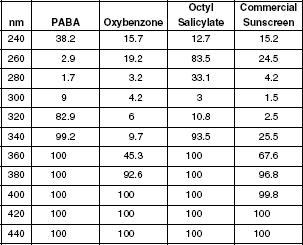
Figure 1 displays the intensity of sunlight across the spectrum.
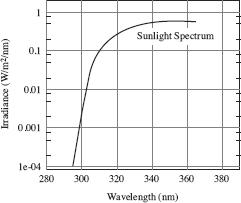
Figure 1
In 1975, Thomas B. Fitzpatrick, MD, Ph.D., of Harvard Medical School, developed a classification system for skin type. This system was based on a person's complexion and responses to sun exposure. Table 2 lists the skin types and their characteristics.
Table 2

According to Table 1, which substance had the highest percent transmittance of UV rays for sunlight with a wavelength of 260 nm?
Octyl salicylate
PABA
Oxybenzone
Commercial sunscreen
Based on the information in Figure 1, sunlight is most intense at which of the following wavelengths?
290 nm
300 nm
320 nm
340 nm
A person with fair skin tone, whose skin burns but also tans slowly, likely has which of the following skin types?
Type I
Type II
Type III
Type IV
Experts state that anyone whose skin is sensitive or very sensitive to UVA should always wear sunscreen. According to Table 2, people with which skin types should always wear sunscreen?
Types I and II
Types I, II, and III
Types II, III, and IV
Types V and VI
In sunlight with an irradiance of 0.01 W/m2/nm, oxybenzone would be expected to have a UV ray percent transmittance of:
3.8
5
9.7
100
